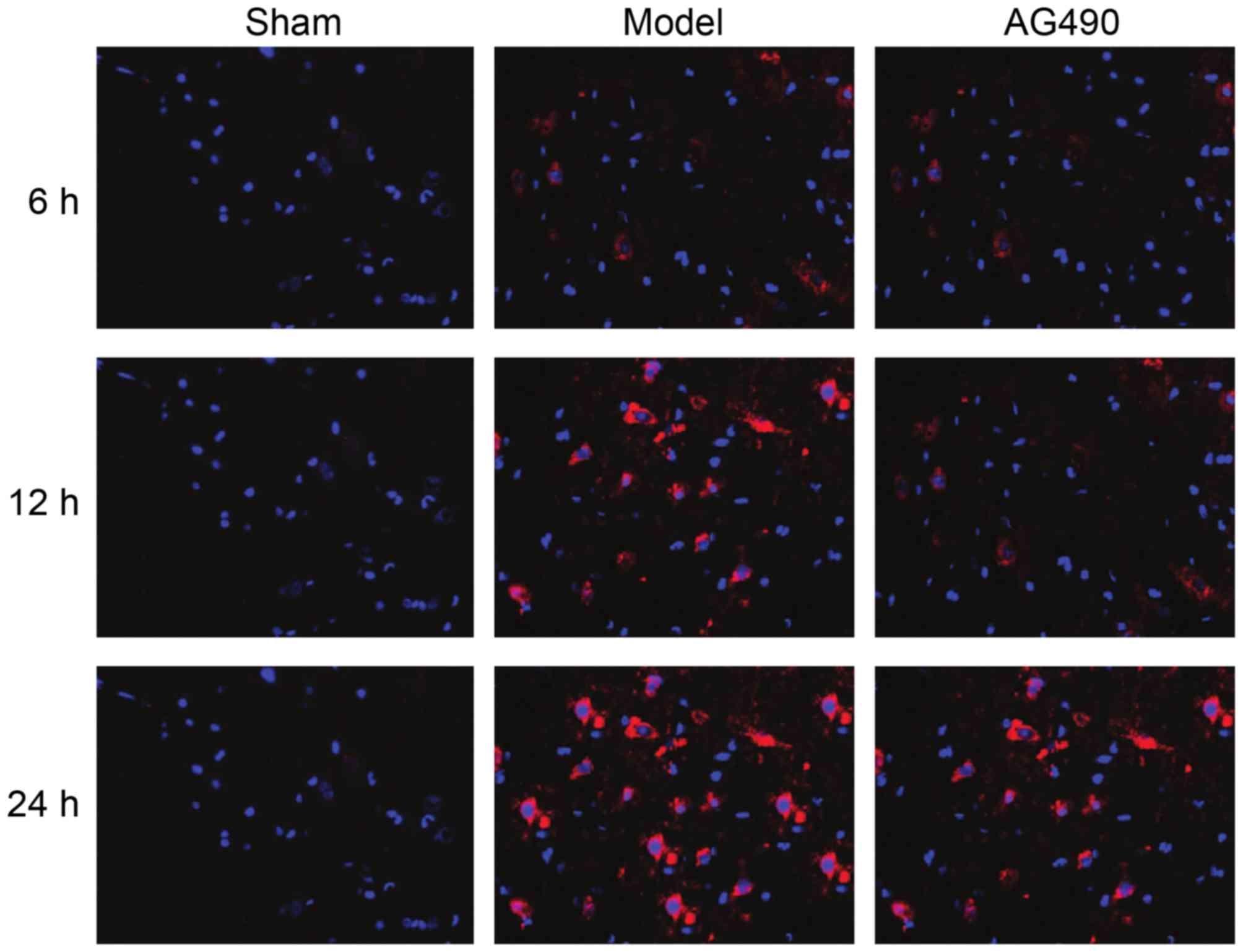|
1
|
Krause JS, Newman JC, Clark JM and Dunn M:
The natural course of spinal cord injury: Changes over 40 years
among those with exceptional survival. Spinal Cord. 5:123–124.
2016.
|
|
2
|
Kwan T, Floyd CL, Kim S and King PH: RNA
binding protein HuR is translocated in astrocytes following spinal
cord injury and promotes the inflammatory response. J Neurotrauma.
6:125–126. 2016.
|
|
3
|
Kanno H, Ozawa H, Sekiguchi A and Itoi E:
Spinal cord injury induces upregulation of Beclin 1 and promotes
autophagic cell death. Neurobiol Dis. 33:143–148. 2009. View Article : Google Scholar : PubMed/NCBI
|
|
4
|
Li G, Jia Z, Cao Y, Wang Y, Li H, Zhang Z,
Bi J, Lv G and Fan Z: Mitochondrial division inhibitor 1
ameliorates mitochondrial injury, apoptosis, and motor dysfunction
after acute spinal cord injury in rats. Neurochem Res.
40:1379–1392. 2015. View Article : Google Scholar : PubMed/NCBI
|
|
5
|
Sekiguchi A, Kanno H, Ozawa H, Yamaya S
and Itoi E: Rapamycin promotes autophagy and reduces neural tissue
damage and locomotor impairment after spinal cord injury in mice. J
Neurotrauma. 29:946–956. 2012. View Article : Google Scholar : PubMed/NCBI
|
|
6
|
Erlich S, Alexandrovich A, Shohami E and
Pinkas-Kramarski R: Rapamycin is a neuroprotective treatment for
traumatic brain injury. Neurobiol Dis. 26:86–93. 2007. View Article : Google Scholar : PubMed/NCBI
|
|
7
|
Wang S, Liu Y, Wu C, Zhao W, Zhang J, Bao
G, Xu G, Sun Y, Chen J and Cui Z: The expression of IGFBP6 after
spinal cord injury: Implications for neuronal apoptosis. Neurochem
Res. 5:154–155. 2016.
|
|
8
|
Morales JK, Falanga YT, Depcrynski A,
Fernando J and Ryan JJ: Mast cell homeostasis and the JAK-STAT
pathway. Genes Immun. 11:599–608. 2010. View Article : Google Scholar : PubMed/NCBI
|
|
9
|
Lai SY and Johnson FM: Defining the role
of the JAK-STAT pathway in head and neck and thoracic malignancies:
Implications for future therapeutic approaches. Drug Resist Updat.
13:67–78. 2010. View Article : Google Scholar : PubMed/NCBI
|
|
10
|
Liu H, Yao YM, Yu Y, Dong N, Yin HN and
Sheng ZY: Role of Janus kinase/signal transducer and activator of
transcription pathway in regulation of expression and
inflammation-promoting activity of high mobility group box protein
1 in rat peritoneal macrophages. Shock. 27:55–60. 2007. View Article : Google Scholar : PubMed/NCBI
|
|
11
|
Kang MK and Kang SK: Interleukin-6 induces
proliferation in adult spinal cord-derived neural progenitors via
the JAK2/STAT3 pathway with EGF-induced MAPK phosphorylation. Cell
Prolif. 41:377–392. 2008. View Article : Google Scholar : PubMed/NCBI
|
|
12
|
Suzuki S, Tanaka K and Suzuki N:
Ambivalent aspects of interleukin-6 in cerebral ischemia:
Inflammatory versus neurotrophic aspects. J Cereb Blood Flow Metab.
29:464–479. 2009. View Article : Google Scholar : PubMed/NCBI
|
|
13
|
Kong LY, Abou-Ghazal MK, Wei J,
Chakraborty A, Sun W, Qiao W, Fuller GN, Fokt I, Grimm EA,
Schmittling RJ, et al: A novel inhibitor of signal transducers and
activators of transcription 3 activation is efficacious against
established central nervous system melanoma and inhibits regulatory
T cells. Clin Cancer Res. 14:5759–5768. 2008. View Article : Google Scholar : PubMed/NCBI
|
|
14
|
Wang G, Zhou D, Wang C, Gao Y, Zhou Q,
Qian G and DeCoster MA: Hypoxic preconditioning suppresses group
III secreted phospholipase A2-induced apoptosis via JAK2-STAT3
activation in cortical neurons. J Neurochem. 114:1039–1048.
2010.PubMed/NCBI
|
|
15
|
Xiong H, Zhang ZG, Tian XQ, Sun DF, Liang
QC, Zhang YJ, Lu R, Chen YX and Fang JY: Inhibition of JAK1,
2/STAT3 signaling induces apoptosis, cell cycle arrest, and reduces
tumor cell invasion in colorectal cancer cells. Neoplasia.
10:287–297. 2008. View Article : Google Scholar : PubMed/NCBI
|
|
16
|
Yang QZ, Lei C, Lu ZH, Wang BR and Xiong
LZ: Neuroprotective effects of combined application of JAK-STAT
signal pathway inhibitor and free radical scavenger on focal
cerebral ischemia/reperfusion injury in rats. Zhongguo Wei Zhong
Bing Ji Jiu Yi Xue. 20:641–644. 2008.(In Chinese). PubMed/NCBI
|
|
17
|
Song Y, Zeng Z, Jin C, Zhang J, Ding B and
Zhang F: Protective effect of ginkgolide B against acute spinal
cord injury in rats and its correlation with the Jak/STAT signaling
pathway. Neurochem Res. 38:610–619. 2013. View Article : Google Scholar : PubMed/NCBI
|
|
18
|
Hou H, Zhang L, Zhang L and Tang P: Acute
spinal cord injury in rats should target activated autophagy. J
Neurosurg Spine. 20:568–577. 2014. View Article : Google Scholar : PubMed/NCBI
|
|
19
|
Zhang YB, Li SX, Chen XP, Yang L, Zhang
YG, Liu R and Tao LY: Autophagy is activated and may protect
neurons from degeneration after traumatic brain injury. Neurosci
Bull. 24:143–149. 2008. View Article : Google Scholar : PubMed/NCBI
|
|
20
|
Zhou Z, Chen S, Zhao H, Wang C, Gao K, Guo
Y, Shen Z, Wang Y, Wang H and Mei X: Probucol inhibits neural cell
apoptosis via inhibition of mTOR signaling pathway after spinal
cord injury. Neuroscience. 329:193–200. 2016. View Article : Google Scholar : PubMed/NCBI
|
|
21
|
Gökce EC, Kahveci R, Gökce A, Cemil B,
Aksoy N, Sargon MF, Kısa Ü, Erdoğan B, Güvenç Y, Alagöz F, et al:
Neuroprotective effects of thymoquinone against spinal cord
ischemia-reperfusion injury by attenuation of inflammation,
oxidative stress, and apoptosis. J Neurosurg Spine. 24:949–959.
2016. View Article : Google Scholar : PubMed/NCBI
|
|
22
|
Li CM, Xie SJ, Wang T, Du WB, Yang ZB and
Quan RF: Effects of electro-acupuncture on neuronal apoptosis and
associative function in rats with spinal cord injury. Zhongguo Gu
Shang. 28:733–738. 2015.(In Chinese). PubMed/NCBI
|













